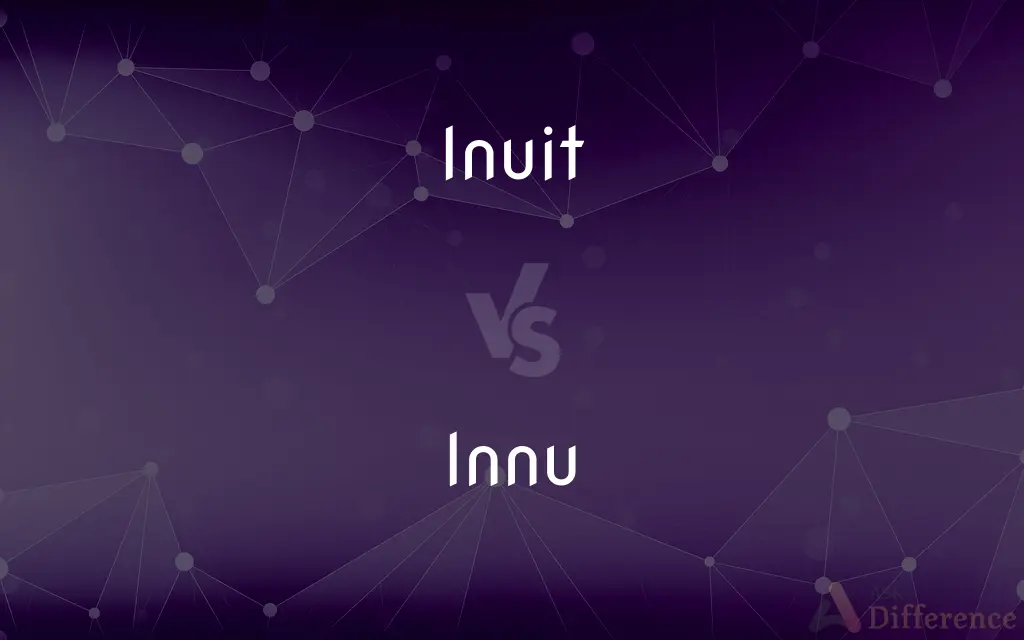Inuit vs. Innu — What's the Difference?
By Maham Liaqat & Urooj Arif — Updated on March 7, 2024
Inuit are indigenous peoples of the Arctic regions of Canada, Greenland, and Alaska, known for their igloos and kayaks, while Innu are Native Americans from northeastern Quebec and Labrador, known for their caribou hunting.

Difference Between Inuit and Innu
Table of Contents
ADVERTISEMENT
Key Differences
The Inuit historically inhabit the Arctic regions of Canada, Greenland, Alaska, and parts of Russia, adapting to extremely cold environments. They are renowned for their unique cultural practices such as igloo building, wearing sealskin, and hunting with dog sleds. Whereas the Innu, also known as the Naskapi and Montagnais, are indigenous peoples primarily from northeastern Quebec and Labrador in Canada. They live in forested, subarctic regions and have a distinct culture centered around hunting, particularly caribou, and fishing.
The Inuit language, part of the Eskimo-Aleut family, varies across regions but shares common roots. It includes several dialects such as Inuktitut and Inuvialuktun. On the other hand, the Innu speak Innu-aimun (or Montagnais), which belongs to the Algonquian language family. This linguistic difference highlights the distinct heritages and cultural narratives of the two groups.
In terms of social organization, Inuit communities have traditionally been small, nomadic groups focusing on family ties and a deep connection with the land. Their survival relies heavily on hunting marine mammals like seals and whales. Conversely, the Innu have historically been more oriented towards the forest interior, relying on caribou hunting as their mainstay, which fostered a semi-nomadic lifestyle, with communities moving with the caribou herds.
The Inuit are known for their art, particularly carvings, printmaking, and the famous Inukshuk landmarks. These cultural expressions often reflect their deep spiritual connection with nature. Meanwhile, the Innu culture is rich in storytelling, music, and traditional crafts such as tanning hides and making birchbark canoes, reflecting their woodland environment and the importance of caribou in their lives.
The challenges faced by both groups in modern times also differ. The Inuit have been more directly impacted by climate change, as warming temperatures affect the ice and wildlife central to their way of life. The Innu, while also facing environmental challenges, have been more engaged in issues of land rights and autonomy, striving to protect their traditional lands from industrial development.
ADVERTISEMENT
Comparison Chart
Region
Arctic Canada, Greenland, Alaska, Russia
Northeastern Quebec and Labrador, Canada
Language Family
Eskimo-Aleut
Algonquian
Lifestyle
Nomadic, marine hunting (seals, whales)
Semi-nomadic, forest hunting (caribou)
Cultural Practices
Igloo building, dog sleds, sealskin garments
Caribou hunting, birchbark canoes, tanning hides
Environmental Challenges
Climate change impacts on ice and wildlife
Land rights, industrial development impacts
Compare with Definitions
Inuit
Known for igloos, a traditional Inuit shelter.
He learned to construct an igloo during his stay with the Inuit.
Innu
Innu-aimun is the language spoken by the Innu.
She teaches Innu-aimun to children in the community.
Inuit
The Inuit are indigenous people of the Arctic.
The Inuit of Nunavut navigate the ice floes with ease.
Innu
The Innu face land rights challenges.
The Innu community is fighting for the protection of their traditional lands.
Inuit
Inuit art is globally recognized.
The gallery exhibited Inuit sculptures and prints.
Innu
The Innu make birchbark canoes.
Crafting birchbark canoes has been an Innu tradition for generations.
Inuit
Dog sleds are a traditional Inuit mode of transport.
They traveled across the tundra by dog sled, a method perfected by the Inuit.
Innu
Caribou hunting is central to Innu culture.
Innu hunters prepare for the annual caribou migration.
Inuit
Climate change greatly affects the Inuit lifestyle.
Inuit communities have observed changes in sea ice patterns over the years.
Innu
The Innu are Native Americans from northeastern Quebec and Labrador.
The Innu have lived in the forests of Labrador for centuries.
Inuit
The Inuit (; Inuktitut: ᐃᓄᐃᑦ 'the people', singular: Inuk, ᐃᓄᒃ, dual: Inuuk, ᐃᓅᒃ) are a group of culturally similar indigenous peoples inhabiting the Arctic regions of Greenland, Canada, and Alaska (United States). The Inuit languages are part of the Eskimo–Aleut languages also known as Inuit-Yupik-Unangan and also as Eskaleut.
Innu
The Innu / Ilnu ("man", "person") or Innut / Innuat / Ilnuatsh ("people"), formerly called Montagnais from the French colonial period (French for "mountain people", English pronunciation: ), are the Indigenous inhabitants of territory in the northeastern portion of the present-day province of Quebec and some eastern portions of Labrador. They refer to their traditional homeland as Nitassinan ("Our Land", ᓂᑕᔅᓯᓇᓐ) or Innu-assi ("Innu Land").
Inuit
The members of various indigenous peoples inhabiting the Arctic from northwest Alaska eastward to eastern Greenland, particularly those inhabiting Canada.
Innu
A member of an Algonquian people comprising the Montagnais and Naskapi.
Inuit
The family of Eskimoan languages spoken by the Inuit.
Inuit
Any of the Eskimoan languages spoken by the Inuit.
Inuit
Of or relating to the Inuit or the languages spoken by the Inuit.
Inuit
A member of a people inhabiting the Arctic (northern Canada or Greenland or Alaska or eastern Siberia); the Algonquians called them Eskimo (`eaters of raw flesh') but they call themselves the Inuit (`the people')
Common Curiosities
Who are the Innu?
The Innu are Native Americans from northeastern Quebec and Labrador, traditionally living in forested, subarctic regions.
Who are the Inuit?
The Inuit are indigenous peoples living in the Arctic regions of Canada, Greenland, Alaska, and Russia, known for their adaptations to cold environments.
What languages do the Inuit speak?
The Inuit speak languages of the Eskimo-Aleut family, including Inuktitut and Inuvialuktun, among others.
What are some environmental challenges faced by the Inuit?
The Inuit face challenges related to climate change, including melting ice and changing wildlife patterns.
What are some challenges faced by the Innu today?
The Innu face challenges related to land rights and protecting their traditional territories from industrial development.
What languages do the Innu speak?
The Innu speak Innu-aimun, part of the Algonquian language family.
How do the artistic traditions of the Inuit and Innu compare?
Inuit artistic traditions include carving and printmaking, often featuring animals and spiritual themes, while Innu art includes storytelling, music, and crafts like tanning hides.
What is traditional Inuit food?
Traditional Inuit food includes marine mammals like seals and whales, fish, and caribou, often consumed raw or dried.
What is a key cultural practice of the Innu?
A key cultural practice of the Innu is caribou hunting, which is central to their way of life and traditions.
How do the Inuit and Innu differ in terms of their traditional homes?
The Inuit are known for constructing igloos out of snow, while the Innu do not traditionally use igloos, favoring tents or other structures suitable for forested areas.
Can you name a traditional Inuit mode of transportation?
A traditional Inuit mode of transportation is the dog sled, used for moving across snow and ice.
What is a unique aspect of Innu cultural practice?
A unique aspect of Innu cultural practice is the making of birchbark canoes, crucial for travel and hunting in their forested environment.
How does the diet of the Inuit differ from that of the Innu?
The Inuit diet is heavily based on marine resources, while the Innu diet includes more terrestrial animals, particularly caribou.
What is the significance of the caribou to the Innu?
The caribou holds significant cultural, spiritual, and subsistence value to the Innu, being central to their way of life.
How are the Inuit adapting to climate change?
The Inuit are adapting through community-based monitoring, advocacy for environmental protection, and adapting their traditional knowledge to changing conditions.
Share Your Discovery

Previous Comparison
Fit vs. Fix
Next Comparison
Angry vs. CrossAuthor Spotlight
Written by
Maham LiaqatCo-written by
Urooj ArifUrooj is a skilled content writer at Ask Difference, known for her exceptional ability to simplify complex topics into engaging and informative content. With a passion for research and a flair for clear, concise writing, she consistently delivers articles that resonate with our diverse audience.
















































